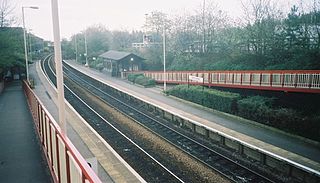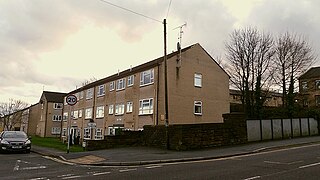
Pudsey is a market town in the City of Leeds Borough in West Yorkshire, England. It is located midway between Bradford city centre and Leeds city centre. Historically in the West Riding of Yorkshire, it has a population of 22,408.

Armley is a district in the west of Leeds, West Yorkshire, England. It starts less than 1 mile (1.6 km) from Leeds city centre. Like much of Leeds, Armley grew in the Industrial Revolution and had several mills, one of which now houses the Leeds Industrial Museum at Armley Mills. Armley is predominantly and historically a largely working class area of the city, still retains many smaller industrial businesses, and has many rows of back-to-back terraced houses.

Yeadon is a town within the metropolitan borough of the City of Leeds, West Yorkshire, England.

Rawdon is a village and civil parish in the metropolitan borough of the City of Leeds, West Yorkshire, England. It sits on the River Aire and on the A65 south of Yeadon.

Barwick-in-Elmet is a village in West Yorkshire, 7 miles (11 km) east of Leeds city centre. It is one of only three places in the area to be explicitly associated with the ancient Romano-British kingdom of Elmet, the others being Scholes-in-Elmet and Sherburn-in-Elmet.

Eccleshill is an area, former village, and ward within the City of Bradford Metropolitan District Council in the county of West Yorkshire, England. The ward population of Eccleshill is 17,540, increasing at the 2011 Census to 17,945. Eccleshill is a more or less completely residential urban area with very little open space although there is substantial open land directly to the east.

New Pudsey railway station serves the towns of Farsley and Pudsey in West Yorkshire, England, on the Calder Valley line. It serves the adjacent suburb of Thornbury.

Farsley is a town in the City of Leeds metropolitan borough, West Yorkshire, England, 6 miles (9.7 km) to the west of Leeds city centre, 4 miles (6.4 km) east of Bradford. Farsley is situated between the two cities and near the town of Pudsey. Before April 1974, Farsley was part of the Borough of Pudsey. Before 1934 it was its own urban district council. It had its own council offices opposite the cenotaph, which is now a dental practice. The ward of Calverley and Farsley also includes the estate of Swinnow and some northern parts of Pudsey.

Calverley is a village in the City of Leeds metropolitan borough in West Yorkshire, England, on the A657 road, about ten miles (16 km) from Leeds city centre and four miles (7 km) from Bradford, and lying north of the town of Pudsey. The population of Calverley in 2011 was 4,328. It is part of the City of Leeds ward Calverley and Farsley, with a population of 22,594 at the 2011 Census.
Stanningley is a district of Pudsey, West Yorkshire, England. It is situated approximately 5 miles (8 km) west of Leeds city centre on the A647 road, the original main road from Leeds to Bradford. The appropriate Leeds Metropolitan Ward is Bramley and Stanningley. The parish is part of the Anglican Diocese of Leeds.

Pudsey Beck is a watercourse in West Yorkshire, England which borders Fulneck (Leeds) and Tong Village (Bradford). It forms the southern and eastern boundary of the area of Pudsey town, after which it is named, and continues as Farnley Beck along the northern edge of Farnley.

Leeds Town Hall is a 19th-century municipal building on The Headrow, Leeds, West Yorkshire, England. Planned to include law courts, a council chamber, offices, a public hall, and a suite of ceremonial rooms, it was built between 1853 and 1858 to a design by the architect Cuthbert Brodrick. With the building of the Civic Hall in 1933, some of these functions were relocated, and after the construction of the Leeds Combined Court Centre in 1993, the Town Hall now serves mainly as a concert, conference and wedding venue, its offices still used by some council departments. It was designated a Grade I listed building in 1951.

Pudsey Grammar School is a secondary school with a sixth form in Pudsey, West Yorkshire, England. It serves over 1300 pupils from the town and surrounding area. The school has a large Sixth Form of over 260 students offering 20 A level courses and 6 Applied General courses.

The architecture of Leeds, a city and metropolitan borough in West Yorkshire, England, encompasses a wide range of architectural styles and notable buildings. As with most northern industrial centres, much of Leeds' prominent architecture is of the Victorian era. However, the City of Leeds also contains buildings from as early as the Middle Ages such as Kirkstall Abbey, one of Britain's best preserved ruined Cistercian monasteries, as well as examples of 20th century industrial architecture, particularly in the districts of Hunslet and Holbeck.

Briggs Priestley was an English cloth manufacturer and Liberal Party politician from Bradford in West Yorkshire.

Yeadon Town Hall is a municipal building in Yeadon, West Yorkshire, England. It is Grade II listed.
The Pudsey loop was a railway line in the former West Riding of Yorkshire, England, which served the town of Pudsey and later offered a second connection between Bramley in the east and Laisterdyke and Dudley Hill in the west, in addition to the existing line between Leeds and Bradford Exchange station.

Pudsey Lowtown railway station is a closed railway station in Pudsey, in the former West Riding of Yorkshire, located about 5 mi (8 km) west of Leeds station. It served the eastern parts of the town of Pudsey.

Otley Civic Centre is a municipal structure in Cross Green, Otley, West Yorkshire, England. The structure, which was the offices and meeting place of Otley Town Council, is a Grade II listed building.


















